| ( ! ) Warning: Undefined array key "blockId" in /home/kbxmjwdb/public_html/wp-content/plugins/table-of-contents-block/table-of-contents-block.php on line 159 | ||||
|---|---|---|---|---|
| Call Stack | ||||
| # | Time | Memory | Function | Location |
| 1 | 0.0001 | 353992 | {main}( ) | .../index.php:0 |
| 2 | 0.0001 | 354352 | require( '/home/kbxmjwdb/public_html/wp-blog-header.php ) | .../index.php:17 |
| 3 | 0.1149 | 10458152 | require_once( '/home/kbxmjwdb/public_html/wp-includes/template-loader.php ) | .../wp-blog-header.php:19 |
| 4 | 0.2051 | 18170736 | include( '/home/kbxmjwdb/public_html/wp-content/themes/generatepress/single.php ) | .../template-loader.php:106 |
| 5 | 0.2752 | 19640944 | generate_do_template_part( $template = 'single' ) | .../single.php:29 |
| 6 | 0.2752 | 19640944 | get_template_part( $slug = 'content', $name = 'single', $args = ??? ) | .../theme-functions.php:568 |
| 7 | 0.2752 | 19641464 | locate_template( $template_names = [0 => 'content-single.php', 1 => 'content.php'], $load = TRUE, $load_once = FALSE, $args = [] ) | .../general-template.php:206 |
| 8 | 0.2752 | 19641576 | load_template( $_template_file = '/home/kbxmjwdb/public_html/wp-content/themes/generatepress/content-single.php', $load_once = FALSE, $args = [] ) | .../template.php:745 |
| 9 | 0.2752 | 19641992 | require( '/home/kbxmjwdb/public_html/wp-content/themes/generatepress/content-single.php ) | .../template.php:812 |
| 10 | 0.2764 | 19689720 | the_content( $more_link_text = ???, $strip_teaser = ??? ) | .../content-single.php:73 |
| 11 | 0.2765 | 19689720 | apply_filters( $hook_name = 'the_content', $value = '<!-- wp:paragraph -->\n<p>These Solutions are part of NCERT Solutions for Class 10 Maths in Hindi Medium. Here we have given NCERT Solutions for Class 10 Maths Chapter 2 Polynomials.</p>\n<!-- /wp:paragraph -->\n\n<!-- wp:paragraph -->\n<p><strong>Chapter 2. बहुपद</strong></p>\n<!-- /wp:paragraph -->\n\n<!-- wp:table-of-contents-block/table-of-contents-block {"headers":[{"level":2,"content":"\\u003cstrong\\u003eप्रश्नावली 2.1\\u003c/strong\\u003e","text":"प्रश्नावली 2.1'... ) | .../post-template.php:256 |
| 12 | 0.2765 | 19690128 | WP_Hook->apply_filters( $value = '<!-- wp:paragraph -->\n<p>These Solutions are part of NCERT Solutions for Class 10 Maths in Hindi Medium. Here we have given NCERT Solutions for Class 10 Maths Chapter 2 Polynomials.</p>\n<!-- /wp:paragraph -->\n\n<!-- wp:paragraph -->\n<p><strong>Chapter 2. बहुपद</strong></p>\n<!-- /wp:paragraph -->\n\n<!-- wp:table-of-contents-block/table-of-contents-block {"headers":[{"level":2,"content":"\\u003cstrong\\u003eप्रश्नावली 2.1\\u003c/strong\\u003e","text":"प्रश्नावली 2.1'..., $args = [0 => '<!-- wp:paragraph -->\n<p>These Solutions are part of NCERT Solutions for Class 10 Maths in Hindi Medium. Here we have given NCERT Solutions for Class 10 Maths Chapter 2 Polynomials.</p>\n<!-- /wp:paragraph -->\n\n<!-- wp:paragraph -->\n<p><strong>Chapter 2. बहुपद</strong></p>\n<!-- /wp:paragraph -->\n\n<!-- wp:table-of-contents-block/table-of-contents-block {"headers":[{"level":2,"content":"\\u003cstrong\\u003eप्रश्नावली 2.1\\u003c/strong\\u003e","text":"प्रश्नावली 2.1'...] ) | .../plugin.php:205 |
| 13 | 0.2768 | 19691664 | do_blocks( $content = '<!-- wp:paragraph -->\n<p>These Solutions are part of NCERT Solutions for Class 10 Maths in Hindi Medium. Here we have given NCERT Solutions for Class 10 Maths Chapter 2 Polynomials.</p>\n<!-- /wp:paragraph -->\n\n<!-- wp:paragraph -->\n<p><strong>Chapter 2. बहुपद</strong></p>\n<!-- /wp:paragraph -->\n\n<!-- wp:table-of-contents-block/table-of-contents-block {"headers":[{"level":2,"content":"\\u003cstrong\\u003eप्रश्नावली 2.1\\u003c/strong\\u003e","text":"प्रश्नावली 2.1'... ) | .../class-wp-hook.php:324 |
| 14 | 0.2778 | 19889488 | render_block( $parsed_block = ['blockName' => 'table-of-contents-block/table-of-contents-block', 'attrs' => ['headers' => [...], 'contentAlign' => 'center'], 'innerBlocks' => [], 'innerHTML' => '\n<div class="wp-block-table-of-contents-block-table-of-contents-block eb-toc-container" style="border:undefinedpx solid black;background:#fff6f3;box-shadow:0px 0px 0px 0px black;width:100%" data-collapsible="false" data-initial-collapse="false" data-scroll-top="false" data-sticky="false" data-text-color="#707070" data-hide-mobile="false" data-title-bg="#ff7d50" data-title-color="white"><div class="eb-toc-header"><div class="eb-toc-title" style="display:block;font-size:22px;font-weight:normal;letter-spacing:'..., 'innerContent' => [0 => '\n<div class="wp-block-table-of-contents-block-table-of-contents-block eb-toc-container" style="border:undefinedpx solid black;background:#fff6f3;box-shadow:0px 0px 0px 0px black;width:100%" data-collapsible="false" data-initial-collapse="false" data-scroll-top="false" data-sticky="false" data-text-color="#707070" data-hide-mobile="false" data-title-bg="#ff7d50" data-title-color="white"><div class="eb-toc-header"><div class="eb-toc-title" style="display:block;font-size:22px;font-weight:normal;letter-spacing:'...]] ) | .../blocks.php:1743 |
| 15 | 0.2778 | 19890088 | WP_Block->render( $options = ??? ) | .../blocks.php:1705 |
| 16 | 0.2779 | 19890784 | {closure:/home/kbxmjwdb/public_html/wp-content/plugins/table-of-contents-block/table-of-contents-block.php:116-270}( $attributes = ['headers' => [0 => [...], 1 => [...], 2 => [...], 3 => [...]], 'contentAlign' => 'center'], $content = '\n<div class="wp-block-table-of-contents-block-table-of-contents-block eb-toc-container" style="border:undefinedpx solid black;background:#fff6f3;box-shadow:0px 0px 0px 0px black;width:100%" data-collapsible="false" data-initial-collapse="false" data-scroll-top="false" data-sticky="false" data-text-color="#707070" data-hide-mobile="false" data-title-bg="#ff7d50" data-title-color="white"><div class="eb-toc-header"><div class="eb-toc-title" style="display:block;font-size:22px;font-weight:normal;letter-spacing:'..., class WP_Block { public $parsed_block = ['blockName' => 'table-of-contents-block/table-of-contents-block', 'attrs' => [...], 'innerBlocks' => [...], 'innerHTML' => '\n<div class="wp-block-table-of-contents-block-table-of-contents-block eb-toc-container" style="border:undefinedpx solid black;background:#fff6f3;box-shadow:0px 0px 0px 0px black;width:100%" data-collapsible="false" data-initial-collapse="false" data-scroll-top="false" data-sticky="false" data-text-color="#707070" data-hide-mobile="false" data-title-bg="#ff7d50" data-title-color="white"><div class="eb-toc-header"><div class="eb-toc-title" style="display:block;font-size:22px;font-weight:normal;letter-spacing:'..., 'innerContent' => [...]]; public $name = 'table-of-contents-block/table-of-contents-block'; public $block_type = class WP_Block_Type { public $api_version = 2; public $name = 'table-of-contents-block/table-of-contents-block'; public $title = 'Table Of Contents'; public $category = 'widgets'; public $parent = NULL; public $ancestor = NULL; public $allowed_blocks = NULL; public $icon = NULL; public $description = 'Insert Table of Contents on your posts/pages and enhance user experience on your WordPress website'; public $keywords = [...]; public $textdomain = NULL; public $styles = [...]; private $variations = NULL; public $variation_callback = NULL; public $selectors = [...]; public $supports = [...]; public $example = NULL; public $render_callback = class Closure { virtual $closure = "{closure}", ... }; public $attributes = [...]; private $uses_context = [...]; public $provides_context = NULL; public $block_hooks = [...]; public $editor_script_handles = [...]; public $script_handles = [...]; public $view_script_handles = [...]; public $view_script_module_ids = [...]; public $editor_style_handles = [...]; public $style_handles = [...]; public $view_style_handles = [...]; private $deprecated_properties = [...] }; public $context = []; protected $available_context = ['postId' => 11247, 'postType' => 'post']; protected $registry = class WP_Block_Type_Registry { private $registered_block_types = [...] }; public $inner_blocks = []; public $inner_html = '\n<div class="wp-block-table-of-contents-block-table-of-contents-block eb-toc-container" style="border:undefinedpx solid black;background:#fff6f3;box-shadow:0px 0px 0px 0px black;width:100%" data-collapsible="false" data-initial-collapse="false" data-scroll-top="false" data-sticky="false" data-text-color="#707070" data-hide-mobile="false" data-title-bg="#ff7d50" data-title-color="white"><div class="eb-toc-header"><div class="eb-toc-title" style="display:block;font-size:22px;font-weight:normal;letter-spacing:'...; public $inner_content = [0 => '\n<div class="wp-block-table-of-contents-block-table-of-contents-block eb-toc-container" style="border:undefinedpx solid black;background:#fff6f3;box-shadow:0px 0px 0px 0px black;width:100%" data-collapsible="false" data-initial-collapse="false" data-scroll-top="false" data-sticky="false" data-text-color="#707070" data-hide-mobile="false" data-title-bg="#ff7d50" data-title-color="white"><div class="eb-toc-header"><div class="eb-toc-title" style="display:block;font-size:22px;font-weight:normal;letter-spacing:'...]; public $attributes = ['headers' => [...], 'contentAlign' => 'center'] } ) | .../class-wp-block.php:463 |
These Solutions are part of NCERT Solutions for Class 10 Maths in Hindi Medium. Here we have given NCERT Solutions for Class 10 Maths Chapter 2 Polynomials.
Chapter 2. बहुपद
प्रश्नावली 2.1
Q1. किसी बहुपद p(x) के लिए, y = p(x) का ग्राफ नीचे आकृति 2.10 में दिया गया है | प्रत्येक स्थिति में, p(x) के शुन्यकों की संख्या ज्ञात कीजिए |
Solution (i):
p(x) के शुन्यकों की संख्या = 0; (क्योंकि ग्राफ रेखा x अक्ष को नहीं काटती है )
Solution (ii):
p(x) के शुन्यकों की संख्या = 1; (क्योंकि ग्राफ x अक्ष को 1 बार काटती है )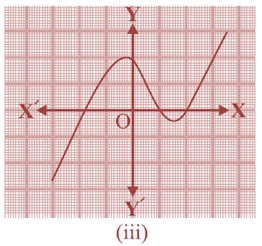
Solution (iii):
p(x) के शुन्यकों की संख्या = 3;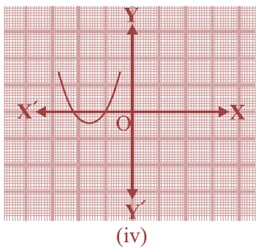
Solution (iv):
p(x) के शुन्यकों की संख्या = 2;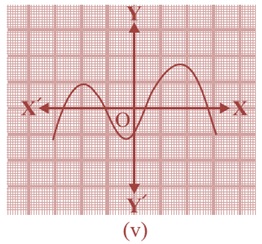
Solution (v):
p(x) के शुन्यकों की संख्या = 4;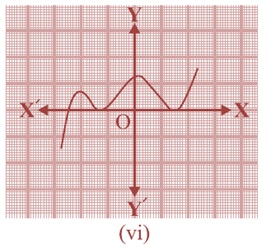
Solution (vi):
p(x) के शुन्यकों की संख्या = 3;
प्रश्नावली 2.2
Q1. निम्न द्विघात बहुपदों के शुन्यक ज्ञात कीजिए और शुन्यकों तथा गुणांकों के बीच संबंध की सत्यता की जाँच कीजिए |
(i) x2 – 2x – 8
a = 1, b = – 2, और c = – 8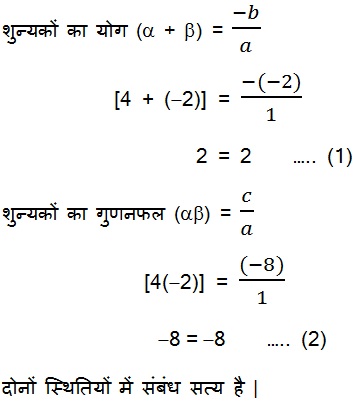
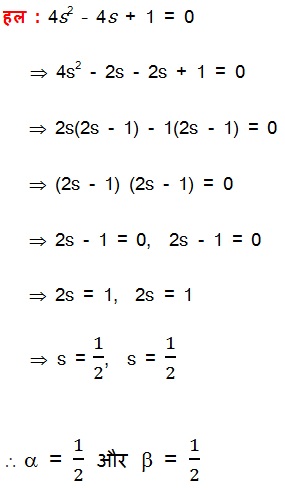
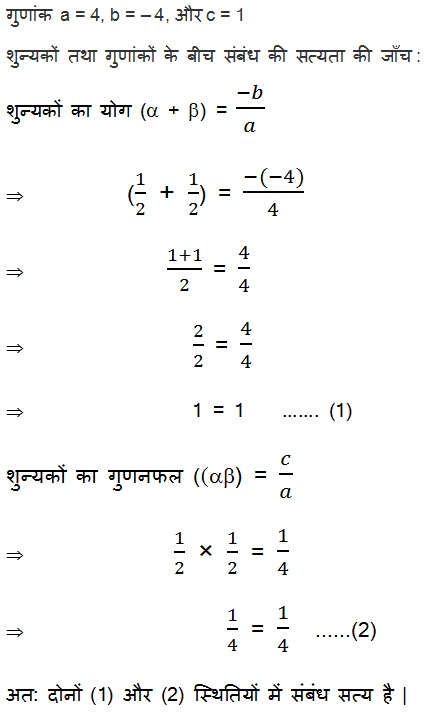
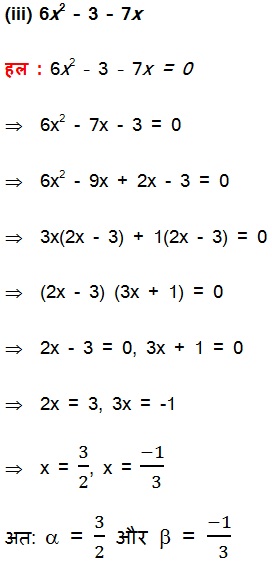

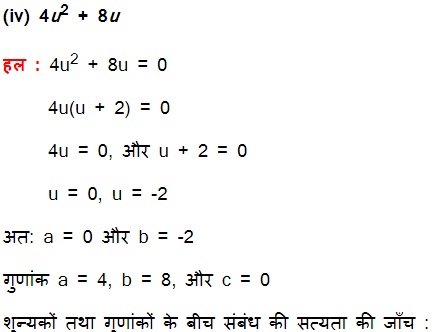
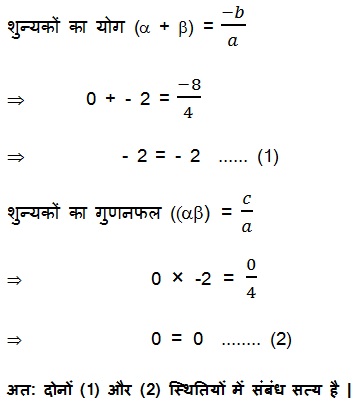
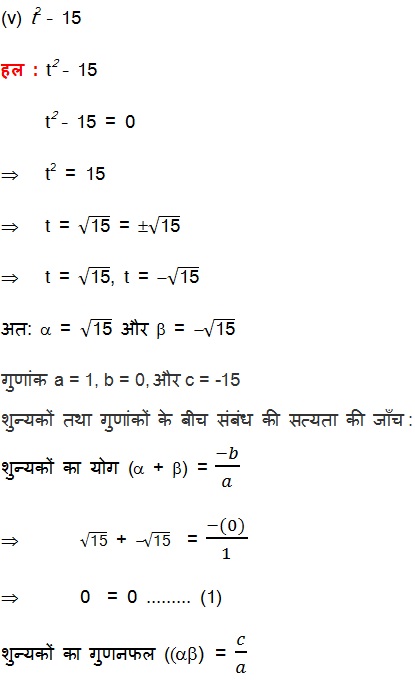
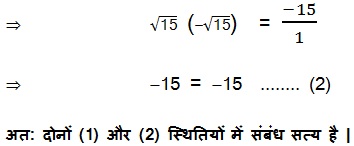
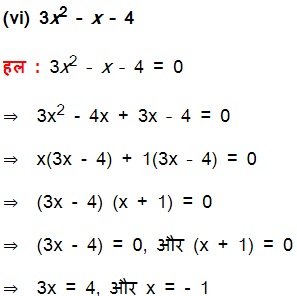
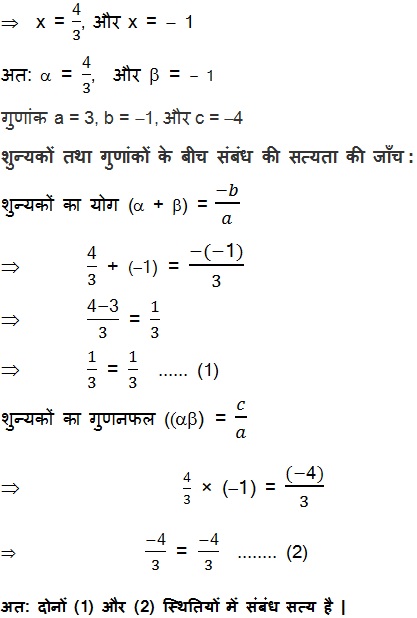
Q2. एक द्विघात बहुपद ज्ञात कीजिए, जिसके शुन्यकों के योग तथा गुणनफल क्रमश: दी गई संख्याएँ हैं : 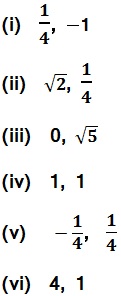
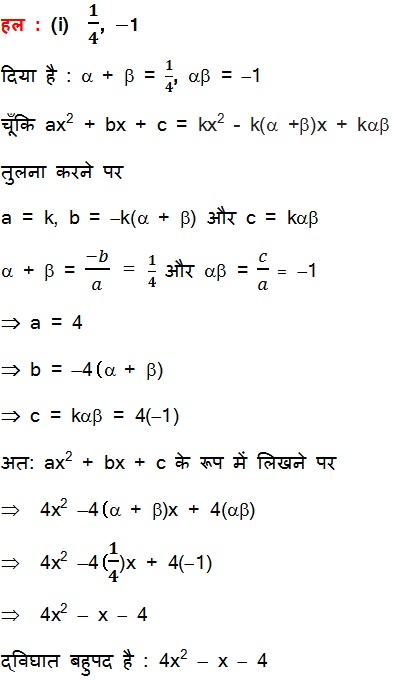
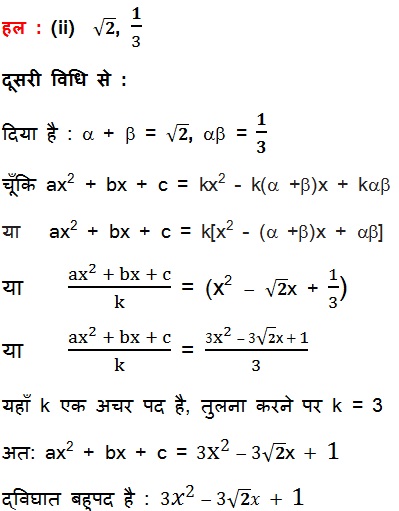



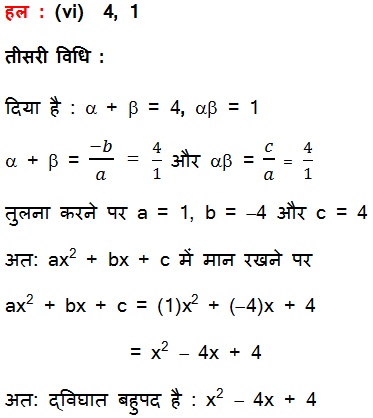
प्रश्नावली 2.3
Q1. विभाजन एल्गोरिथम का प्रयोग करके, निम्न में p(x) को g(x) से भाग देने पर भागफल तथा शेषफल ज्ञात कीजिए :
(i) p(x) = x3 – 3x2 + 5x – 3, g(x) = x2 – 2
(ii) p(x) = x4 – 3x2 + 4x + 5, g(x) = x2 + 1 – x
(iii) p(x) = x4 – 5x + 6, g(x) = 2 – x2
हल : (i) p(x) = x3 – 3x2 + 5x – 3, g(x) = x2 – 2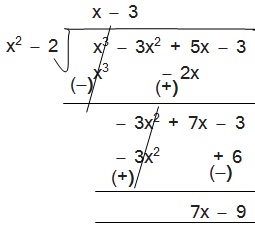
भागफल q(x) = x – 3 और शेषफल = 7x – 9 है |
हल : (ii) p(x) = x4 – 3x2 + 4x + 5, g(x) = x2 + 1 – x
भागफल q(x) = x2 + x – 3 और शेषफल = 8 है |
हल : (iii) p(x) = x4 – 5x + 6, g(x) = 2 – x2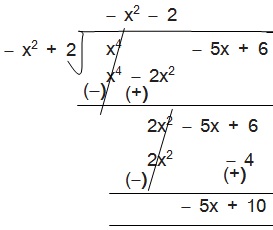
भागफल q(x) = – x2 – 2 और शेषफल = – 5x + 10 है |
Q2. पहले बहुपद से दुसरे बहुपद को भाग करके, जाँच कीजिए कि क्या प्रथम बहुपद द्वितीय का एक गुणनखंड है :
(i) t2 – 3, 2t4 + 3t3 – 2t2 – 9t – 12
(ii) x2 + 3x + 1, 3x4 + 5x3 – 7x2 + 2x + 2
(iii) x3 – 3x + 1, x5 – 4x3 + x2 + 3x + 1
हल : (i) t2 – 3, 2t4 + 3t3 – 2t2 – 9t – 12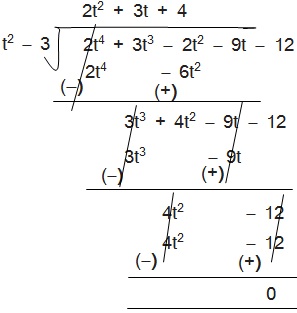
चूँकि शेषफल r(x) = 0 है |
अत: t2 – 3, 2t4 + 3t3 – 2t2 – 9t – 12 का एक गुणनखंड है |
हल : (ii) x2 + 3x + 1, 3x4 + 5x3 – 7x2 + 2x + 2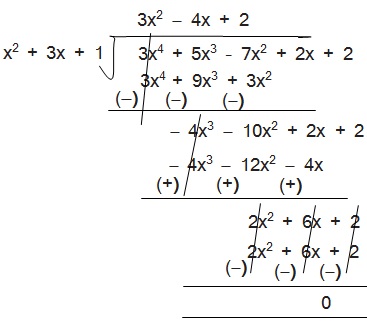
चूँकि शेषफल r(x) = 0 है |
अत: x2 + 3x + 1, 3x4 + 5x3 – 7x2 + 2x + 2 का एक गुणनखंड है |
हल : (iii) x3 – 3x + 1, x5 – 4x3 + x2 + 3x + 1
चूँकि शेषफल r(x) = 2 है |
अत: x3 – 3x + 1, x5 – 4x3 + x2 + 3x + 1 का एक गुणनखंड नहीं है |
हल :
दिया है : p(x) = 3x4 + 6x3 – 2x2 – 10x – 5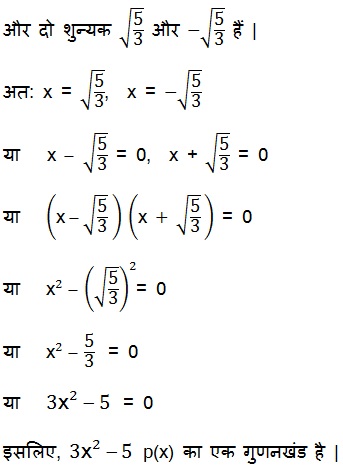
अब 3x2 – 5 से 3x4 + 6x3 – 2x2 – 10x – 5 में भाग देने पर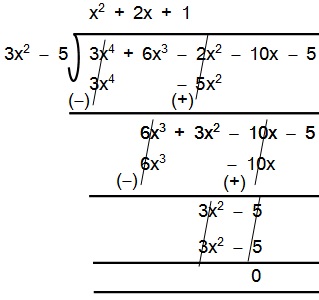
अत: p(x) = (3x2 – 5) (x2 + 2x + 1)
अब, x2 + 2x + 1 को गुणनखंड कर शुन्यक ज्ञात करने पर –
Q4. यदि x3 – 3x2 + x + 2 को एक बहुपद g(x) से भाग देने पर, भागफल और शेषफल क्रमश: x – 2 और – 2x + 4 हैं तो g(x) ज्ञात कीजिए ।
हल :
दिया है : भाज्य p(x) = x3 – 3x2 + x + 2
भागफल q(x) = x – 2,
शेषफल r(x) = – 2x + 4
भाजक g(x) = ?
भाज्य = भाजक × भागफल + शेषफल
p(x) = g(x) × q(x) + r(x)
x3 – 3x2 + x + 2 = g(x) (x – 2) + (- 2x + 4)
x3 – 3x2 + x + 2 + 2x – 4 = g(x) (x – 2)
g(x) (x – 2) = x3 – 3x2 + 3x – 2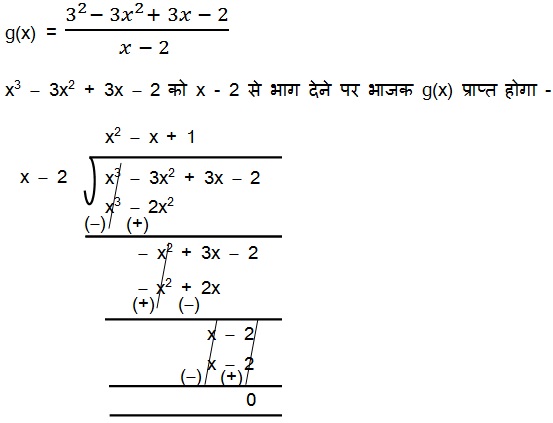
अत: भाजक g(x) = x2 – x + 1 है |
Q5. बहुपदों p(x), g(x), q(x) और r(x) के ऐसे उदाहरण दीजिए जो विभाजन एल्गोरिथम को संतुष्ट करते हों तथा
(i) घात p(x) = घात q(x) हो
(ii) घात q(x) = घात r(x) हो
(iii) घात r(x) = 0 हो
हल :
युक्लिड विभाजन एल्गोरिथम से
p(x) = g(x) × q(x) + r(x) जहाँ q(x) ¹ 0 हो
(i) घात p(x) = घात q(x) हो
भाज्य p(x) और भागफल q(x) की घात सामान तभी हो सकता है जब भाजक g(x)की घात 0 अर्थात कोई संख्या हो |
उदाहरण : माना p(x) = 2x2 – 6x + 3
और माना g(x) = 2
भाग देने पर
p(x) = 2x2 – 6x + 2 + 1
= 2(x2 – 3x + 1) + 1
अब 2(x2 – 3x + 1) + 1 को p(x) = g(x) × q(x) + r(x) से तुलना करने पर हम पाते हैं :
अत: q(x) = x2 – 3x + 1 और r(x) = 1
इससे घात p(x) = घात q(x) प्राप्त होता है |
(ii) घात q(x) = घात r(x) हो
हल : यह स्थिति तब आती है जब p(x) और g(x) का घात सामान हो जैसे –
माना p(x) = 2x2 + 6x + 7 और g(x) = x2 + 3x + 2
भाग देने पर : q(x) = 2 और r(x) = 3
अत: घात q(x) = घात r(x) है |
(iii) घात r(x) = 0 हो
हल : r(x) = 0 तब होता है जब p(x), g(x) से पूर्णत: विभाजित हो :
माना p(x) = x2 – 1 और g(x) = x + 1
विभाजित करने पर
q(x) = x – 1 और r(x) = 0 प्राप्त होता है |
प्रश्नावली 2.4
Q1. सत्यापित कीजिए कि निम्न त्रिघात बहुपदों के साथ दी गई संख्याएँ उसकी शून्यक हैं। प्रत्येक स्थिति में शून्यकों और गुणांकों के बीच के संबंध् को भी सत्यापित कीजिए:
(i) 2x3 + x2 – 5x + 2; α = ½, β = 1 और γ = – 2;
हल :
दिया है : शुन्यक α = ½, β = 1 और γ = – 2 है |
और गुणांक a = 2, b = 1, c = – 5 और d = 2
शुन्यकों और गुणांकों के बीच संबंध की जाँच :








